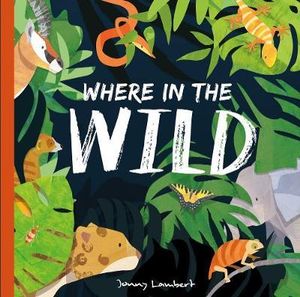Where in the wild by Poppy Bishop and Jonny Lambert

Little Tiger, 2018. ISBN 9781848699557
Inspired by Theodore Roosevelt saying, "The wildlife and its habitat
cannot speak, so we must and we will", this book takes the young
reader on a journey through the world's key habitats and introduces
them to some of the creatures that live within them.
From rivers to jungles, the savannah, the desert, woodlands and the
frozen extremes, familiar and not-so creatures make an appearance in
colourful artwork and rhyming text. Using a double-page spread for
each, the two-verse rhyme begins with an introduction to the habitat
and then an inhabitant "speaks" to the reader about itself. The rest
of the pages are filled with a collage of flora and fauna, each with
a clever cutout featuring a creature that lives in the featured
habitat but which can adapt to the succeeding one to entice the
reader to keep turning, reading and learning. Some of these cutouts
have text which encourages closer observation of the illustrations,
making the reader engage more through this interactivity. The final
message about habitat destruction and the need to protect what is
left is very clear and ties in well with the initial quote.
Often, books from the northern hemisphere tend to feature the
creatures with which children from that part of the world are
familiar but this one spans the globe, although, thankfully, the
polar region is confined to the Arctic so there is not the confusion
of polar bears and penguins on the same page.
As well as being a comprehensive introduction to the world's
habitats so young readers can learn that there is more to this
planet than their immediate surroundings, its strong conservation
message can also lead to inquiries about the inhabitants of their
local area and their protection and promotion; the impact of humans
through the destruction of habitat, particularly deforestation; the
life cycles, needs and adaptation of creatures as their habitats
change (such as described in Moth); and even individual
responsibility and actions that could be taken to preserve what we
have left.
With the drought in eastern Australia drawing our attention to the
land beyond the city environs, this is a great opportunity to have a
look at the broader world and how it copes or doesn't, and this
would be an excellent introductory text.
Barbara Braxton